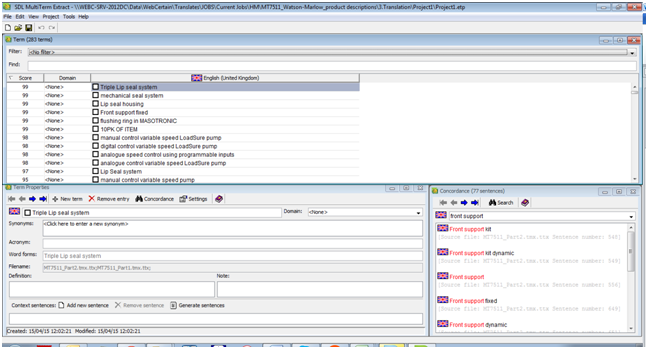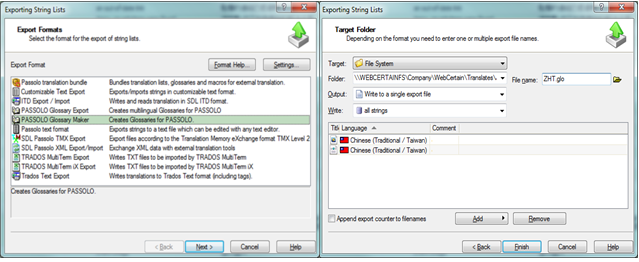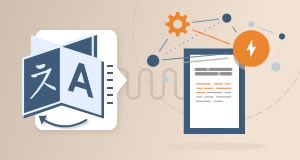When it comes to producing content to fulfil your marketing or corporate communication needs it’s incredibly important to establish a voice for your company, or brand, to be used consistently throughout all materials produced – even more so when your company eventually goes global. Ensuring that the same terminology is used across all business sectors and international markets is key, and the only way that you can truly control this is through a well-established terminology management strategy.
Building a glossary of terms for your home market is just the start, and then this must be carefully reproduced in the local language of each of your overseas territories. This will not only ensure consistency in the internal creation of content but also across any and all content that you usually outsource for translation. Over time costs for translation will be reduced and turnaround times will become shorter increasing efficiency overall.
Why you need to manage your terminology
I thought I’d start with an example of what can happen if you do not make use of a terminology management strategy to illustrate how important implementing a strategy can be. Imagine the following scenario:
You’re launching a new product and somewhere during the initial development stages an inconsistent term is used in the briefing documentation. This product is then adapted slightly to create ten individual models, each with three different versions of the documentation; one for the installer, one for the administrators and one for the final end-user, and so the inconsistency multiplies. These documents are then distributed in three different formats, print, web and CD-ROM. These products are then sold in 15 different countries and therefore all documentation needs localising into the language of these international markets, again the inconsistency follows and multiplies further.
OK so did you keep up? How many times does the initial inconsistency appear now? Let’s recap…
Now the inconsistent use of one single term, which could have been avoided through the use of an established glossary, is replicated 1,350 times across 16 languages instead of appearing once before being noticed. That certainly puts things into perspective, and situations like this can be completely avoided by implementing an efficient terminology management strategy.
Developing clear guidelines
 In order to successfully reproduce your brand on an international scale it’s important that you get a handle on your own language; developing guidelines on the way key words and phrases used by your company and industry are managed in your home market first. Involving relevant people from your team in this process will allow you to understand just who is responsible for coining new terms within your business, and how and where they should be used. If you haven’t created a glossary already then it’s about time you start!
In order to successfully reproduce your brand on an international scale it’s important that you get a handle on your own language; developing guidelines on the way key words and phrases used by your company and industry are managed in your home market first. Involving relevant people from your team in this process will allow you to understand just who is responsible for coining new terms within your business, and how and where they should be used. If you haven’t created a glossary already then it’s about time you start!
Alongside your glossary you might also consider drawing up a company style guide that will be used by your staff, copywriters, translators, technical writers; basically anyone and everyone that creates content for your brand. Include clear instructions on how terminology should be used for particular documentation, or to target a certain audience. You might also want to divide your terms between multiple glossaries, if so this needs to be stipulated in the guidelines to ensure users select the right terminology for the right documentation. Three common types of terminology databases are:
- Traditional Glossaries: includes your company’s/brand’s/industry’s core terminology
- Untranslatable Terminology: includes any terms which should not be translated, such as product names, trademarked or copyrighted names, company name etc.
- UI Glossaries: these are usually created by software developers to pull out all terminology which appears in an application to ensure the same terms are used across supportive material such as help sections and user manuals
Building your primary glossary
Once you’ve identified the stakeholders get them to examine your written content; brochures, marketing materials, website, training materials, instruction manuals, operational manuals etc. From here any and all relevant term candidates can be extracted and used to populate your term-base. My advice here would be “less is more”. Don’t feel like you have to include hundreds and hundreds of terms in your glossary. Pick those super important ones and maximise their use.
Of course you also need to provide some context for when these terms should be used. Adding metadata such as definitions, part of speech, complimentary terms, specific documentation in which particular words are used, will help users to know exactly how and why they should implement specific words and phrases.
It’s also important that you keep things simple by only using the most basic forms of verbs and nouns, avoid using prepositions and articles, and try not to include two letter acronyms either. Adhering to the spelling conventions of your home market (American English vs. Australian English vs. UK English) and conducting a final spell check will also assist in consistency overall.
Once complied, you might ask the opinion of a Subject Matter Expert (SME) to review and validate the terms that have been selected to populate your glossary. Such approval is likely to reduce the risk of having to revise and correct your glossary at a later date. Things to look out for are double entries, conflicting entries, inconsistencies between compound nouns, inconsistent use of product names etc.
Terminology Management

If you require regular translation on an ongoing basis, it is a good idea to keep your bilingual glossary of terms up to date. This is because, as a translator’s key point of reference, a well maintained bilingual glossary will ensure consistency throughout the translation project. After each translation job, your dedicated project manager will examine the text, extract any new terminology and update your bilingual glossary.
Sponsored
Localising your glossary
Once you’ve finalised your primary glossary you need to find a suitable way of localising this into each of your additional languages. If you already work with a language service provider (LSP) then discuss the best way for you to go about this. Most LSPs will have a workflow in place for the translation of glossaries and will be able to advise you on a suitable process for your requirements.
If you are able to involve your in-country teams in this process then ensure you do. Having a native speaker of the target language review the translated glossary will allow them to provide an insight into the most relevant localised term to include in the final database. After all your global teams not only have the language skills, but they also have a deep knowledge of your products and industry.
If International SEO is important for your business then you might also like to integrate local keywords into your bilingual glossary for any website translation projects you might have in the pipeline. Just remember it’s important to conduct a detailed keyword research not translate the keywords as this won’t generate the same results for your international sites. For more information why not have a read of my past blog here.
Updating your bilingual glossaries
In this constantly evolving world it is highly likely that there will be additions to your glossaries over time. Therefore it’s important to consider the best way of going about this. First you need to consider when and who will update your terminology database.
It goes without saying that updating your glossary bang smack in the middle of a project is a big no-no. In my experience it’s best to wait until the end of a project, once the content has been approved and finalised. Extracting any new terms from the content at this stage ensures that moving forward they will be implemented correctly and consistently.
You should also think carefully about which individual should look after integrating new words and phrases into your primary glossary. Perhaps a member of your team or your SME will be responsible for updating your primary glossary, but it’s up to you to set this in place early on. Once translated, your LSP should be able to implement the localised terms into your bilingual glossaries for future translation projects.
Terminology management tools
It’s worth mentioning here that there are various tools available on the market to assist in terminology management, catering to glossaries of varying sizes. Some worth mentioning here are SDL MultiTerm, Term Base eXchange, TermStar, and UniTerm. I would suggest that you investigate the various solutions currently on the market and see which tool will work best for you. For large corporations covering several languages it might also be worth investing in a full Terminology Management System (TMS). Your LSP should be able to discuss the options with you and offer their insight and experience to help you make the right decision.
Although brief I hope this introduction to terminology management has helped you to understand the real importance of implementing a suitable solution for managing the use of terminology across your company. By making a move towards implementing a well thought out strategy you are also moving closer to a more streamline approach which will increase consistency, reduce costs for translation and make the process of content creation more efficient. Even though you will have to dedicate serious time and resources to build and implement your glossaries the rewards will be so worth it in the end!
Emily MacKenzie
Latest posts by Emily MacKenzie (see all)
- What is SEO-localisation? - May 11, 2018
- Agile processes for continuous delivery: A focus on SEO-localisation - May 11, 2018
- E-book review: Undertaking SEO-localisation in a world of continuous delivery - May 11, 2018










